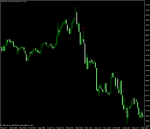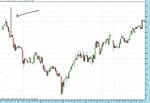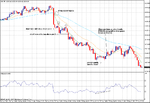trader_dante
Veteren member
- Messages
- 4,535
- Likes
- 1,704
Tips and Tricks *Part 1*
This is that start of a 13 part series called Tips and Tricks which will discuss some of the ways I increase my profitability when trading.
The first area I want to discuss is how to sometimes "cheat" your SB broker for an optimal entry into the market. If you don't spreadbet then you can skip this post altogether as it may not be of much use to you.
Please note that I don't do this every time I trade. Having an opportunity to do so is rare. However, it helps to know that these opportunities exist from time to time and how to exploit them.
First off, I don't want to get everyone sidetracked on how you can all make free money in the markets. For the most part you can no longer do this. There was a time when you could make a huge amount of money trading broker errors but as time goes by, it gets harder and harder to profit from these opportunities.
I've made several posts on this in my time on this forum and written lengthy articles on how to profit from your broker via latency scalping and what I call "untrue volatility", on other forums and it's not something I want to repeat now on this thread. If you want links to these, send me a PM and I will provide them for you.
What I will say is that if you are trading in an unfamiliar market it may help you to spend sometime looking at the PRICE very carefully. To many traders pull up a chart to judge when to enter the market and don't spend anytime looking at the actual bid-offer QUOTE.
As most of you are aware, spreadbetting is a DERIVATIVE of the underlying market - albeit one that is very closely linked most of the time. However, I have found many markets on many different brokers often experience a volatilty that a trader can take advantage of.
I call this "untrue volatility". It is where the price "spikes" to levels that the direct market is not currently trading at and then corrects itself almost instantaneously,
You can see a clear example of this in the charts attached. Chart 1 shows the direct market quote for Spot Gold and chart 2 shows a spreadbet brokers quote for Spot Gold. I have used a red arrow to highlight a 15m period (3 5m bars) on the first chart. The arrows on the second chart correspond to the same time period.
As you can see it would have been possible to make a profit of approximately 50 points in a matter of seconds. Before you get too excited I should say that this happens rarely and nowadays most brokers will reverse your trade if they find out you have done it. You can still sometimes get under the radar but it is more the exception than the rule.
However, rather than using this spiking to get a PROFIT (entering on the spike and closing on the correction - therefore trading the "error") there is a way in some markets to get a BETTER entry into the market you want to trade.
To take a hypothetical example, my broker quotes Spot Gold with a large degree of volatility, at certain times, that means I can usually get a price at least 5 ticks better off than my entry by buying or selling at the market rather than using an order.
If you actually watch the quote alongside a direct market quote you will notice volatility that is SPECIFIC to the sb broker. If spot Gold is trading at 800 you may see the offer come in at 800...800.10...800.20...799.50...800.20...800.30 and so on. The price on some markets jumps around a lot more than this and you have to be fast.
Again, if you are like I was (until yesterday) and busy at work, it will be enough to place an order and walk away. However, if you have time, it is worth looking at the quote for a few minutes to see if you notice anything unusual.
As I said above, this is NOT an important part of my strategy, it is simply something I have become aware of over time and is why I like to look at the actual price quote where I can.
This is that start of a 13 part series called Tips and Tricks which will discuss some of the ways I increase my profitability when trading.
The first area I want to discuss is how to sometimes "cheat" your SB broker for an optimal entry into the market. If you don't spreadbet then you can skip this post altogether as it may not be of much use to you.
Please note that I don't do this every time I trade. Having an opportunity to do so is rare. However, it helps to know that these opportunities exist from time to time and how to exploit them.
First off, I don't want to get everyone sidetracked on how you can all make free money in the markets. For the most part you can no longer do this. There was a time when you could make a huge amount of money trading broker errors but as time goes by, it gets harder and harder to profit from these opportunities.
I've made several posts on this in my time on this forum and written lengthy articles on how to profit from your broker via latency scalping and what I call "untrue volatility", on other forums and it's not something I want to repeat now on this thread. If you want links to these, send me a PM and I will provide them for you.
What I will say is that if you are trading in an unfamiliar market it may help you to spend sometime looking at the PRICE very carefully. To many traders pull up a chart to judge when to enter the market and don't spend anytime looking at the actual bid-offer QUOTE.
As most of you are aware, spreadbetting is a DERIVATIVE of the underlying market - albeit one that is very closely linked most of the time. However, I have found many markets on many different brokers often experience a volatilty that a trader can take advantage of.
I call this "untrue volatility". It is where the price "spikes" to levels that the direct market is not currently trading at and then corrects itself almost instantaneously,
You can see a clear example of this in the charts attached. Chart 1 shows the direct market quote for Spot Gold and chart 2 shows a spreadbet brokers quote for Spot Gold. I have used a red arrow to highlight a 15m period (3 5m bars) on the first chart. The arrows on the second chart correspond to the same time period.
As you can see it would have been possible to make a profit of approximately 50 points in a matter of seconds. Before you get too excited I should say that this happens rarely and nowadays most brokers will reverse your trade if they find out you have done it. You can still sometimes get under the radar but it is more the exception than the rule.
However, rather than using this spiking to get a PROFIT (entering on the spike and closing on the correction - therefore trading the "error") there is a way in some markets to get a BETTER entry into the market you want to trade.
To take a hypothetical example, my broker quotes Spot Gold with a large degree of volatility, at certain times, that means I can usually get a price at least 5 ticks better off than my entry by buying or selling at the market rather than using an order.
If you actually watch the quote alongside a direct market quote you will notice volatility that is SPECIFIC to the sb broker. If spot Gold is trading at 800 you may see the offer come in at 800...800.10...800.20...799.50...800.20...800.30 and so on. The price on some markets jumps around a lot more than this and you have to be fast.
Again, if you are like I was (until yesterday) and busy at work, it will be enough to place an order and walk away. However, if you have time, it is worth looking at the quote for a few minutes to see if you notice anything unusual.
As I said above, this is NOT an important part of my strategy, it is simply something I have become aware of over time and is why I like to look at the actual price quote where I can.








